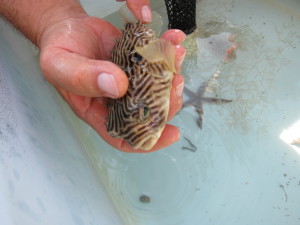 The Magnuson-Stevens Fishery Conservation and Management Act (MSA) (16 U.S.C. §§ 1801 et seq.), and the 1996 Sustainable Fisheries Act amendments to the MSA, established the requirements for sustainable fisheries management plans, in response to, among other things, “direct and indirect habitat losses which have resulted in a diminished capacity to support existing fishing levels”. The MSA and its references to habitat losses are important in terms of adaptation to climate change because this language could provide a potential statutory rationale for the ecologic and economic significance of wetlands, and thus the importance of insuring the continued existence of coastal wetlands in the face of sea level rise.
The Magnuson-Stevens Fishery Conservation and Management Act (MSA) (16 U.S.C. §§ 1801 et seq.), and the 1996 Sustainable Fisheries Act amendments to the MSA, established the requirements for sustainable fisheries management plans, in response to, among other things, “direct and indirect habitat losses which have resulted in a diminished capacity to support existing fishing levels”. The MSA and its references to habitat losses are important in terms of adaptation to climate change because this language could provide a potential statutory rationale for the ecologic and economic significance of wetlands, and thus the importance of insuring the continued existence of coastal wetlands in the face of sea level rise.
Identifying Essential Fish Habitat
The amendments specifically directed the eight regional fishery management councils established under the MSA to identify the “essential fish habitat” (EFH) for each federally managed fish species. EFH is defined as those waters and substrate necessary to fish for spawning, breeding, feeding or growth to maturity and may include migratory routes, open waters, wetlands, estuarine habitats, artificial reefs, shipwrecks, mangroves, mussel beds, and coral reefs. The regional councils are required to identify EFH for each fishery and any potential adverse effects to that habitat from fishing and nonfishing related activities. Once the councils have identified EFH, federal agencies must consult with the Secretary of Commerce (via NOAA Fisheries) regarding whether their actions may adversely affect EFH. Of primary importance to wetlands, consultation is required prior to the issuance of CWA Section 404 wetland permits.
The evolution of the implementation of the fisheries management plans and essential fish habitat is still young. The 5 year review of the Gulf of Mexico Fishery Management Council Essential Fish Habitat progress was released in 2010. Given that almost all commercially important species depend on estuarine wetlands, it would seem logical to include these wetlands as part of the official EFH of any fisheries management plan. And it appears that the fishery management councils are doing just that. The Gulf Coast Fishery Management Council’s EFH Final Environmental Impact Statement (FEIS), for example, shows the landward line of the EFH to be the boundary between estuarine and palustrine wetlands or uplands as defined in the USFWS’s National Wetland Inventory maps (Gulf Fisheries Management Council, 2004). The FEIS gives the following specific definition: For the estuarine component, EFH is all estuarine waters and substrates (mud, sand, shell, rock and associated biological communities); subtidal vegetation (seagrasses and algae); and adjacent inter-tidal vegetation (marshes and mangroves). In marine waters of the Gulf of Mexico, EFH is virtually all marine waters and substrates (mud, sand, shell, rock and associated biological communities) from the shoreline to the seaward limit of the EEZ (exclusive economic zone).
Designating Habitat Areas of Particular Concern
The Gulf Coast FIS also designates Habitat Areas of Particular Concern (HPAC), the designation of which “is intended to identify to anyone considering actions that might be potentially threatening to habitat those areas of EFH considered to be of the highest importance in the life cycles of managed species and most in need of protection. An HAPC is expected to be a localized area of EFH that is especially ecologically important, sensitive, stressed, or rare when compared to the rest of EFH.” The general focus of Gulf Coast EIS is on fishing impacts on EFH and HPAC and therefore contains no discussion of destruction of EFH-associated wetlands as a result of urban development or other non-fishing activities.
Essential Fish Habitat and Section 404 Permitting
As mentioned above, EFH can figure prominently in Section 404 wetland permit actions as the Corps is required to consult with NOAA Fisheries regarding the impact of development activities on EFH. While estuarine wetlands are already protected under Section 404 of the Clean Water Act, the requirement to consult on Section 404 permits for potential disturbance or destruction of EFH adds an additional layer of review, and could conceivably provide a mechanism to protect inundatable near-shore dry lands to protect essential habitat in the future.
An interesting question to contemplate would be whether inundatable lands just inland from sea-level-rise marshes could be considered as Habitat Areas of Particular Concern under the MSA.



